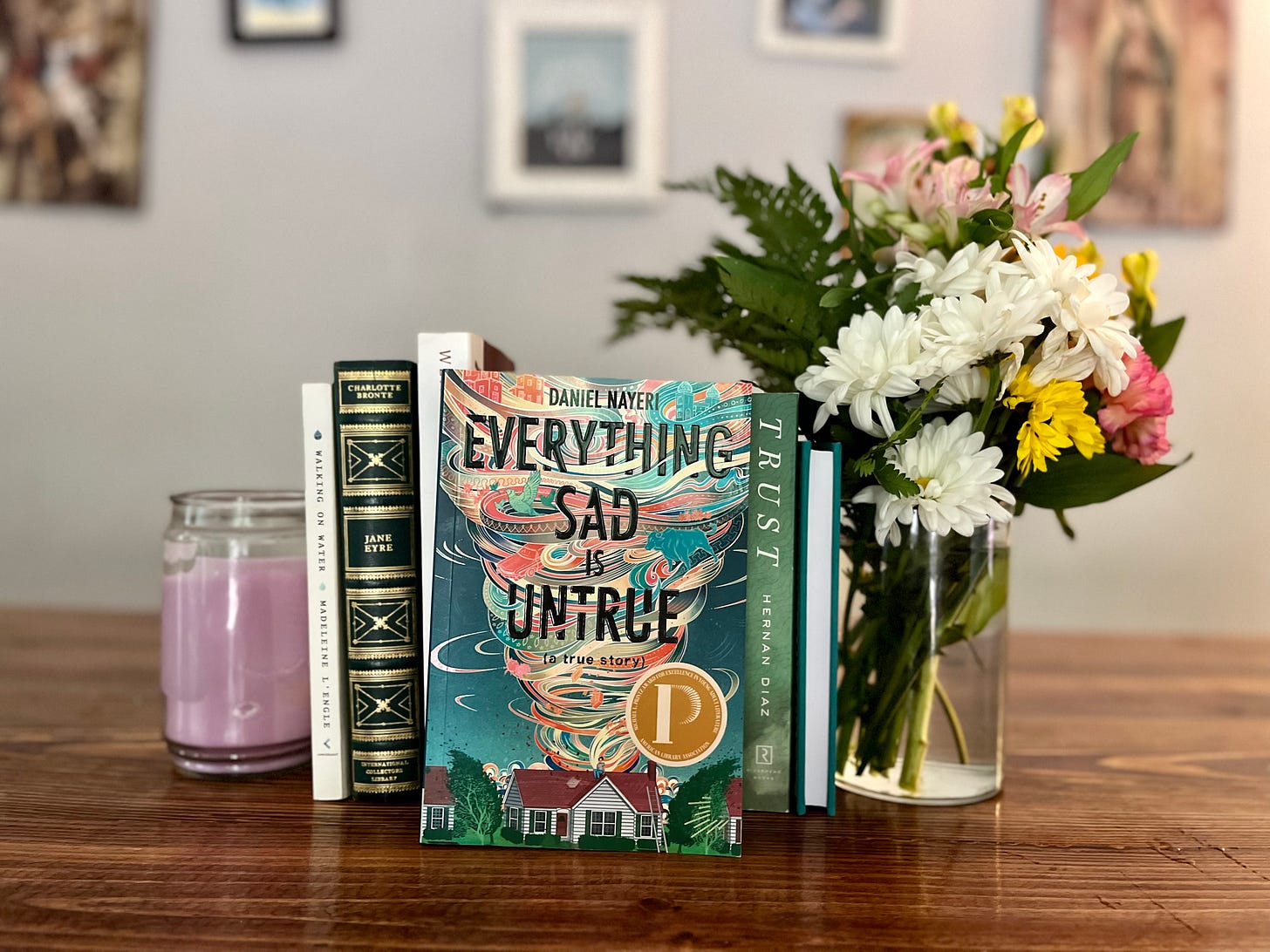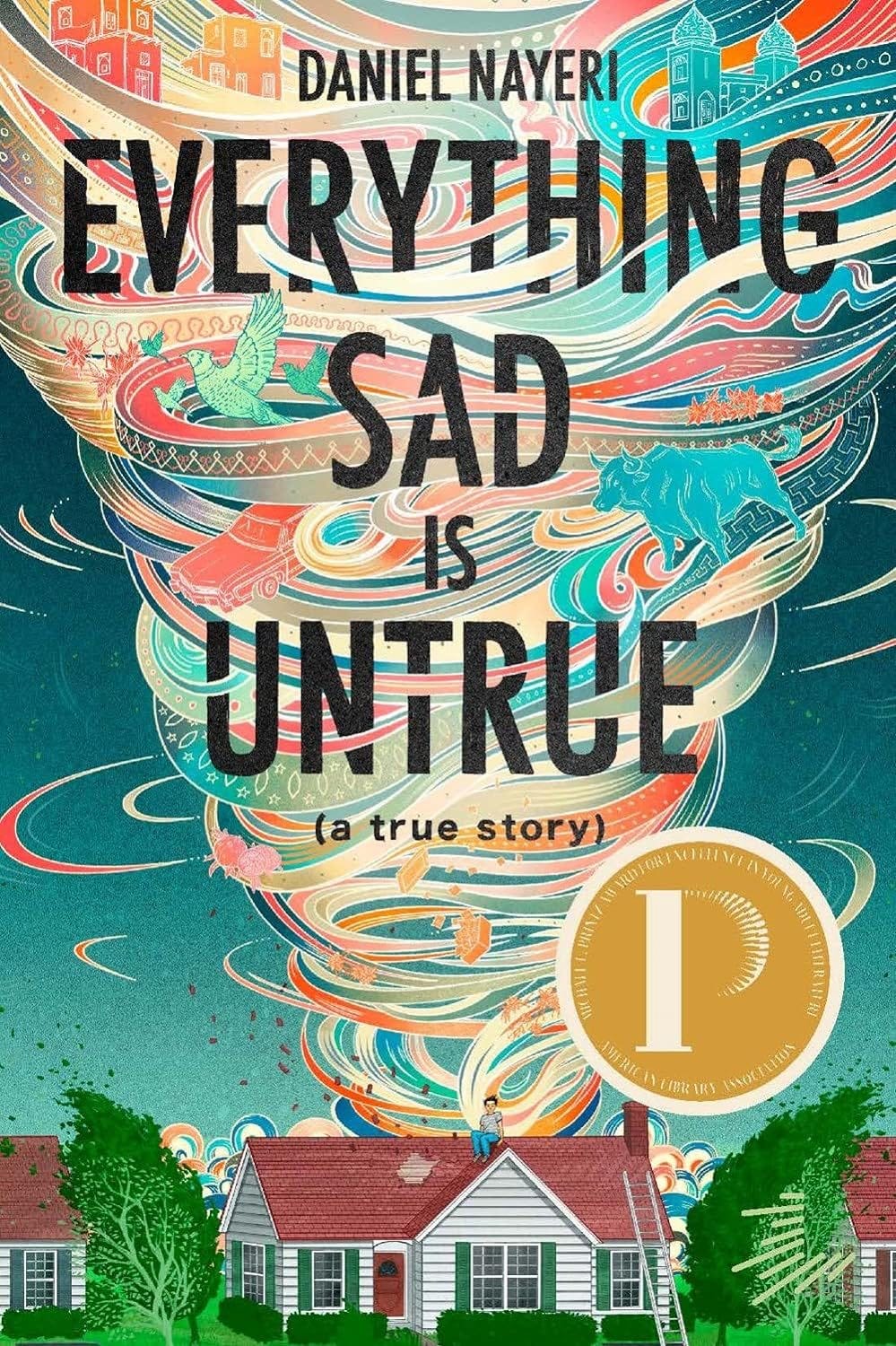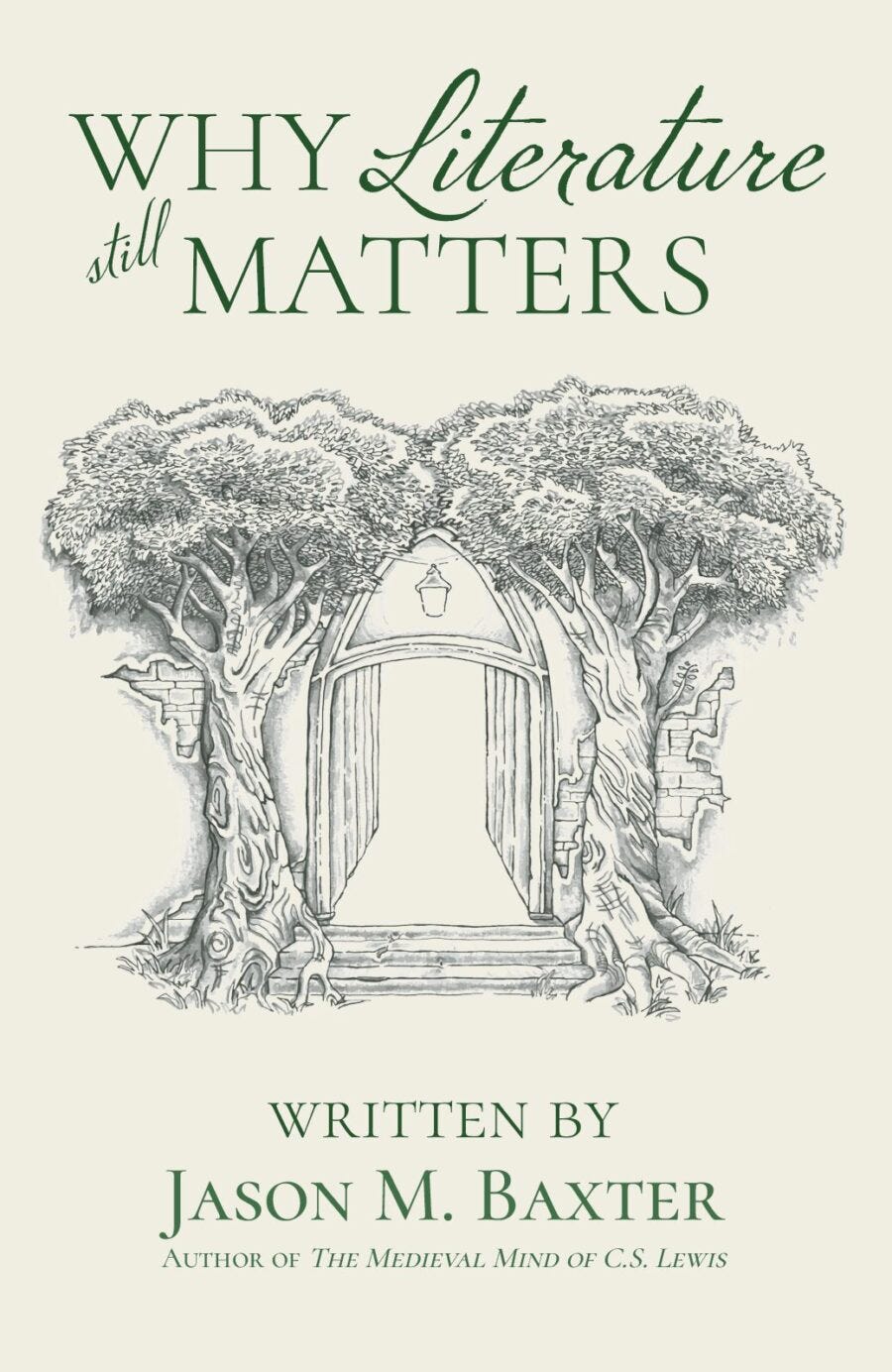Everything Sad is Untrue (pgs 238-351)
in which we come to the end and contemplate story and memory
I had been thinking about 1,001 Nights and wondering what would happen if Scheherazade was sick or dizzy one night and fell asleep right in front of the villain king. Or what would happen if she ran out of stories, her mind went blank, and she knew if she didn’t keep talking, he would kill her. Would she start recounting her memories?
….
Would the memories curve into themselves into a perfect round river? A red river? A heart pumping blood in and out in perfect circulation? What if it goes on forever, the telling and retelling? When did all these words begin? Are they all just distant memories we are passing to each other?
And what if, like a rug, they are flawed? Memories are just stories we tell ourselves, after all. What if we are telling ourselves lies? (349)
Hello Readers,
I hope you enjoyed the end of the story this week. Last week we ended with the tornado and this week we jumped right back into the story with the rest of Daniel’s family escape from Iran, their time in Dubai, and Italy. Back in Oklahoma we also get to meet his dad in the present day (not just in the memories). And we finally see someone stand up to Ray!
Again, I am not going to try to give a full summary or cover everything we have read. That would be borderline impossible and a much longer post than you have time to read. I am going to choose a few “Things I Couldn’t Help But Notice” and elaborate from there. This story is woven together so expertly that I couldn’t possibly explain it all, nor do I want to. I hope that you have noticed things I haven’t and that those insights can enliven our Book Club discussions.
Now onto the end of the book….
Mrs. Miller says I have “lost the plot,” and am now just making lists of things that happened to fill space. But I replied that she is beholden to a Western mode of storytelling that I do not accept and that the 1,001 Nights are basically Scheherazade stalling for time, so I don’t see the difference.
…
The point of the Nights is that if you spend time with each other — if we really listen in the parlors of our minds and look at each other as we were meant to be seen — then we would fall in love. We would marvel at how beautifully we were made. (300-301)
Story Structure
As we come to the end of the book I am wondering if the book has a chiastic structure. I noticed that the direct middle of the book is the part where Daniel says poop is the truest thing about a person. But the event at the middle is his mother’s conversion. Because the story starts where it begins (with the bull), it made me think that you could chart out a chiastic structure. He also doesn’t start telling poop stories until midway through the first half and then he stops telling poop stories midway through the second part. If anyone else wants to chart out more specifics, I would be very interested to see what other connections can be made!
Or maybe this is just pointing to the more cyclical storytelling of the Eastern tradition.
“O wise and merciful Mrs. Miller, every story is nestled somehwere within another story.” (258)
The Hole in the Rug
I don’t even remember the moment my dad left us…It’s the not-remembering that makes it one giant hole in the middle of a rug. Like somebody didn’t even care to address it…When you ask, they never quite tell you. (242)
In this section we are introduced to the theme of the Persian rug. It has been alluded to before, but Daniel finally starts parsing it out here. I think this is significant for a number of reasons. We have the way his memories are weaved together in the stories he tells. We also have the fact that there are so many myths and legends weaved into his story and the magic carpet is one of the very well known parts of Persian mythology even to us westerners. And finally we have “The Persian Flaw.” Daniel explains that this is something all rug makers put into their rug to remind them that only God is perfect.
The truth is, in the real world there’s no such thing as a Persian Flaw, because that assumes you could have a thing that has only one thing wrong with it….The truth is that everything has a hundred thousand flaws. But it’s pretty to think that we can make perfect things and scratch them a little to keep from being gods. It’s comforting, the way in myths the heroes are all one personality flaw from perfection. (257)
The way that Daniel connects the Persian Flaw not only to rugs and people, but also to memory is so interesting to me. The hole in himself is the fact that he is missing memories. Or that his memories don’t match other people’s. While him and his sister are literally weaving mini Persian rugs (“mug rugs”) they are having conversations about their memories and specifically how hurtful it can be when their memories differ.
Myth Becomes Fact
Throughout this whole book we have been hearing/reading Daniel’s actual memories weaved together with his memories of myths and legends that were told to him. It’s a beautiful way to tell a story. But in this section it seems like we get much less of the memories and more of the real life.
Once they flee Iran and get to Dubai they run into an actual prince. It feels like the myths and legends are all of the sudden walking into their real life. At first this seemed simply to be a fun twist on the story telling, but as I read more I was convinced that there was something more going on. The Prince, instead of being purely evil (and trying to kill them) or purely good (and saving them with no ulterior motives) is actually a flawed human. He is on drugs and is willing to help them if they give him what he wants (which is unfortunately to marry the young girl). It seems like a random story in the story, but I think not.
I think this might be foreshadowing for Daniel’s dad coming to Oklahoma. Up until the moment we meet his dad in “real time” (though that is complicated because what we experience as real time is Daniel’s twelve year old self, when in reality the author is very far removed from that time), we think of his dad in almost a mythic way. I think Daniel does too. When he walks off the plane we immediately experience with Daniel how much smaller he is than he remembers. He is suddenly a flawed human being, not some mythic prince. He is real. He has the one hundred thousand flaws that human beings have.
Naming and Renaming
Something new that I noticed in this section was that a lot of our main characters are not specifically named until later in the story. The fact that these characters don’t have names doesn’t seem significant because Daniel refers to them as his sister, his mom, and his dad. But as soon as each character gets a name, I all of the sudden realized I hadn’t know their name that whole time. The name then almost works its way backwards through the story.
The first time I noticed this was when his mom gets named. It is right after she converts to Christianity. After that her name, Sima, is used regularly in the book. Then Dina, his sister, is first named after she stands up to Ray. These are both brave actions that change the course of the family’s life. I don’t remember when Daniel’s dad first gets a name, so I am not sure if it is significant.
Renaming is also always significant and Daniel is the only one who gets renamed (I think). This happens when they are in the process of fleeing and he is traumatized. If his mom and sister get named only after their brave actions, what does it mean that Daniel gets renamed in a weak moment? In the Bible people usually get renamed for what they are called to do. Daniel is named after Daniel in the Bible. Is he being called to bravery and courage like Daniel in the Lion’s Den?
Mr. Sheep Sheep Redeemed
We cannot leave this book without talking about Mr. Sheep Sheep one more time! He comes back to Daniel. Almost like he is resurrected from the dead. All of the imagery of the good shepherd and the lost sheep are so referential to the gospels. I love that Mr. Sheep Sheep comes back but he is injured. He has the scars.
Then we have the terribly awkward sermon that the pastor preaches directly to Daniel’s dad. Watching the evangelical spirit come into contact with Persian hospitality is packed with meaning I’m not ready to draw out yet. What I am thinking about is that he is preaching on the parable of the lost sheep, which seems to bring Mr. Sheep Sheep out of the land of myth and into the land of Christianity. All of which seems appropriate to the story. Expertly done!
The Blood of the Bull and the Blood of the Cross
The fact that the book begins and ends with the story of his grandpa and the bull not only alerted me to the possibility of a chiasm, but noting that the conversion scene is in the middle helped me connect the story to Christianity not only in theme but in structure. As Christians we cannot help but think of Christ whenever there is an animal being sacrificed. God used the whole Old Testament story to lead us to understand the New Testament sacrifice of Christ on the cross.
It seems like Daniel is mirroring this in his story. We get the initial memory of the sacrifice of the bull, plenty of myths, legends, and histories, the conversion of Sima to Christianity, how it affects Daniel’s present life, and then the real meaning of the sacrifice of the bull. It is like Daniel is teaching us through his memories what he has come to understand about Christ.
I also noticed that we don’t get Daniel’s conversion moment, only his mom and his sister’s. But he obviously understands it much more than his dad and the other adults in the story. It makes me think that the structure of the story is pointing to the way his conversion worked out, whether fully in reality or at least in memory. I think ending the story this way is so much more satisfying than a simple scene of Daniel having a lightbulb conversion moment.
Thank you Daniel for letting us borrow your memories. I for one hope that I have been changed by them. I love stories so much and this seems like exactly what story should be!
“Of course. You were his. He would have also made a feast,” she added. “But it would have been a sheep. He would have spilled the blood. You have to understand that means a blessing. It’s ancient. To step over the river of blood, to accept the sacrifice and be thankful. Then we could eat, only after we understand the cost of joy. And he would have washed his hands.” (351)
Discussion Questions
Is the ending to the story satisfying?
Muse on the themes we’ve noticed
Fatherlessness
Memory
Story
The relationship between myth, legends, and history
Conversion
Do you have a favorite story within the story? Or a section that sticks with you?
Has the story changed you like Daniel hoped it would?
Have you read 1,001 Nights? If so, how does it affect your reading of this story?
This is a middle grade novel…What age would you let your kids (if you have them) read this book?
How does this change the way you view your past and memories?
Everything Sad is Untrue Reading Schedule
Monday, June 16th- ep. 60: Intro to Everything Sad is Untrue w/ Heidi White
Wednesday, June 18th: Introduction and Schedule (you are here)
Wednesday, June 25th: pgs. 1-119
Wednesday, July 2nd: pgs. 119-238
Wednesday, July 9th: pgs 238-351 (but don’t forget to read the Author’s Note at the very end)
Monday, August 4th: ep. 67: Revisiting Everything Sad is Untrue
Until next time, keep revisiting the good books that enrich your life and nourish your soul.
What We’re Reading Now/Next:
July
Everything Sad is Untrue by Daniel Nayeri
August
Northanger Abbey by Jane Austen
September
Why Literature Still Matters by Jason Baxter
A Few Reminders:
If you are wanting to get in on the in person or virtual community please contact us!
We have turned on paid subscriptions which will allow you to support the work we are doing here as well as receive Read Along Guide PDFs each month and voice recordings of the Read Along Guides.
If you would like to make a small contribution to the work we’re doing here at Reading Revisited, we invite you to do so with the Buy (Us) a Coffee button below. We so appreciate your support!
*As always, some of the links are affiliate links. If you don’t have the books yet and are planning to buy them, we appreciate you using the links. The few cents earned with each purchase you make after clicking links (at no extra cost to you) goes toward the time and effort it takes to keep Reading Revisited running, and we appreciate it!










This was such a delightful book. I was actually a bit skeptical of it, but am so glad to have read it. A lot of soul searching about my own faith convictions (have I really fallen in love with a person the way Sima has, do I have the Hope that makes her unstoppable? When do I fall into the trap of the either/or God who listens/speaks? How do I practice charity-in a truly welcoming way, or in a grudging/off-putting way that reduces the dignity of the other even further?) the ending was just so heart-breaking in a lot of ways, because you get this taste of a happy ending with his father’s return, but the father chooses to leave again. He isn’t really willing to practice the self-sacrificial love of a parent, just the fun/exciting parts.
This was a lovely discussion on the book. I remember being surprised by Daniel’s uncharacteristic certainty in speaking about Christ.
“Christ has died. Christ is risen. Christ will come again.” And he said it was absolutely true.
I love this thought, because, when we are drawn into memory of our own stories or even Christian conversion experiences, there is much to question. But the object of our faith is certain, so I think we can accept the uncertainty of our memory without being undone by it.
Like Annelise, I had so many thoughts that I *almost* wrote a post on it. It’s a very powerful book, and I think I’d wait until my daughter is at least 11 before she reads it. I’m curious how it might affect a particularly sensitive young person.